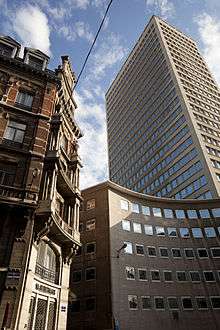Maison du Peuple
| Maison du Peuple | |
|---|---|
_(destroyed%2C_Brussels)%2C_exterior_2.jpg) View of Maison du Peuple in the late 19th century or early 20th century | |
| Alternative names |
Volkshuis People’s Home |
| General information | |
| Status | Demolished |
| Type | Political headquarters premises |
| Architectural style | Art Nouveau |
| Location | Brussels, Belgium |
| Coordinates | 50°50′28″N 4°21′09″E / 50.84111°N 4.3525°ECoordinates: 50°50′28″N 4°21′09″E / 50.84111°N 4.3525°E |
| Named for | Workers (Belgian Workers' Party) |
| Completed | 1899 |
| Technical details | |
| Material | White cast iron |
| Design and construction | |
| Architect | Victor Horta |
The Maison du Peuple (in French) or Volkshuis (in Dutch), both literally translated as The People’s Home or The People’s House, was a public building located on Emile Vandervelde Square, near the Sablon, in Brussels. It was one of the most influential Art Nouveau buildings in Belgium and one of the most notable designs by Belgian architect Victor Horta.[1][2] Commissioned by the Belgian Workers' Party,[1] it was constructed between 1896 and 1899, and opened on 2 April 1899.[3]
The building was demolished in 1965, and a skyscraper was built on its site.[2] Its demolition has been regarded as an "architectural crime" and an example of "Brusselization".[2][3]
Building
Victor Horta was commissioned by the Belgian Workers' Party to build a grandiose people's house on Emile Vandervelde Square. He was assisted for this project by Richard Pringiers, who was to become the appointed architect of the party.
.jpg)
In spite of a rather restrictive, very irregular plot along a circular square and on a slope, Horta succeeded to construct a building with maximum functionality. The building provided rooms for offices, coffee shops, shops, meeting rooms and a party hall.[4][5] It was mainly constructed in white iron (more than 600,000 kg [1,300,000 lb]). Fifteen craftsmen worked for eighteen months on the ironwork. To make this construction possible, Horta drew no less than 8,500 m2 (91,000 sq ft) of plans.
The building was completed in 1899 and was inaugurated in the presence of the French socialist leader Jean Jaurès.[3][4][5] Because of the experimental combination of brick, glass, and steel, it was considered as a masterwork of modern architecture.
- Interior of the Maison du Peuple
_(destroyed%2C_Brussels)%2C_theatre_hall.jpg) Theatre hall
Theatre hall_(destroyed%2C_Brussels)%2C_dining_hall.jpg) Dining hall
Dining hall
Demolition
In spite of an international protest movement of over 700 architects, the building was demolished in 1965.[3][4][5] The building was dismantled entirely with the idea of rebuilding it elsewhere. However, its components were scattered in vacant lots around Brussels, and it was never reconstructed. Later, structural parts of the building were used in the Horta Grand Café in Antwerp and some of the original pieces can still be found in the Horta premetro station in Saint-Gilles.[3]
The loss of the Maison du Peuple was part of the trend of Brusselization, where many historic buildings were torn down and replaced by skyscrapers. The Maison du Peuple itself was replaced by a 26-floor office building, the Blaton Tower, built the year immediately after the Maison du Peuple's demolition.[3]

See also
References
- 1 2 Thake, Conrad (2011). "A PROJECT FOR A 'CENTRO D'ITALIANITÀ' IN MALTA". Malta Historical Society. Melita Historica. XV (4): 434–436. ISSN 1021-6952. OCLC 472457132. Archived from the original on 17 December 2016.
- 1 2 3 Art Nouveau Architecture Picture Tour: Maison du Peuple
- 1 2 3 4 5 6 "The Disappearance of the Maison du Peuple or the assassination of Victor Horta". Retrieved 2018-08-19.
- 1 2 3 "eBru | La Maison du Peuple | Victor Horta | Art nouveau | Bruxelles". www.ebru.be. Retrieved 2018-08-19.
- 1 2 3 "Victor Horta Most Important Art | TheArtStory". The Art Story. Retrieved 2018-08-19.